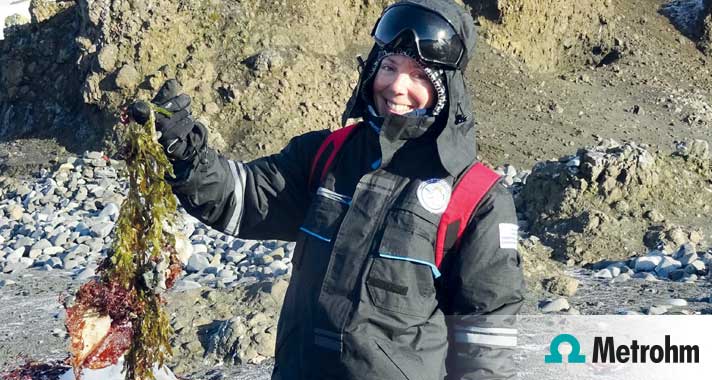María Fernanda Cerdá collecting red algae on King George Island for her solar cells research.
Traveling to Antarctica might sound like traveling to the very end of the world for many. Still, scientists from the University of the Republic in Uruguay take this trip upon them to do research at the country’s Scientific Antarctic Base «Artigas» (BCAA in Spanish), situated at 3012 kilometres from the Uruguayan capital Montevideo. Among them is María Fernanda Cerdá. Here she is on the joys and strains of being a researcher in Antarctica.
María’s project at the Antarctic base was to collect red algae on King George Island, extract the dyes responsible for their colour, and select those with the proper characteristics to assemble a dye-sensitised solar cell, which will need to be performed after returning to Montevideo. The first part of the work is to compare the colour of the extracts obtained with different solvents and select those with the deepest red. To be suitable for solar cells, however, the dyes have to combine two properties: in addition to high extinction coefficients at suitable wavelengths, high oxidation potentials are required. Only a dye exhibiting both properties can transfer the electrons to the semiconductor of the cell, and thereby make it possible to harvest electricity from the cell.
Unlike the extinction coefficients which can be estimated by an experienced eye, you will need the help of an instrument to measure the oxidation potentials of your dyes – preferably a small instrument that is light and easy to use, such as the ones from DropSens. Weighing less than half a kilogram, the portable potentiostat «µStat 400» is well within luggage restrictions. The device works with screen-printed electrodes that combine the working electrode, reference electrode, and counter electrode in one handy sensor and require only a drop of solution. This means that only small quantities of sample and of electrolyte solution are required for the measurements. The µStat 400 helped the researcher identify potentially suitable dyes for solar cells by shedding light on their oxidation behaviour. In addition to that, there are three main reasons to choose this potentiostat — especially when working at a place like the BCAA: its small size, its light weight, and the fact that measurements don’t generate waste that has to be flown back to the continent.









